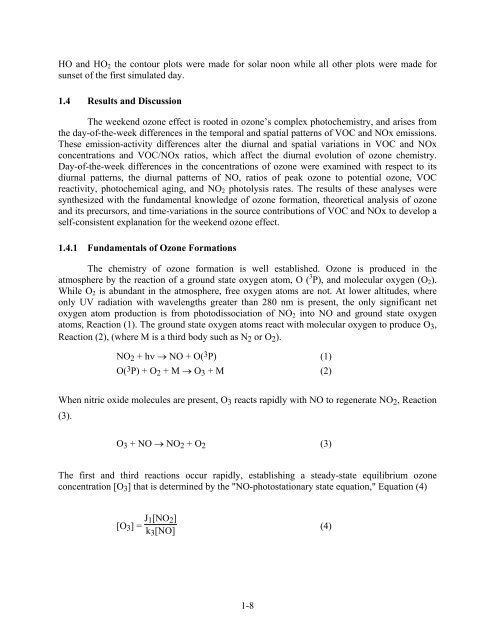Weekend/Weekday Ozone Observations in the South Coast Air Basin
Weekend/Weekday Ozone Observations in the South Coast Air Basin
Weekend/Weekday Ozone Observations in the South Coast Air Basin
Create successful ePaper yourself
Turn your PDF publications into a flip-book with our unique Google optimized e-Paper software.
HO and HO 2 <strong>the</strong> contour plots were made for solar noon while all o<strong>the</strong>r plots were made for<br />
sunset of <strong>the</strong> first simulated day.<br />
1.4 Results and Discussion<br />
The weekend ozone effect is rooted <strong>in</strong> ozone’s complex photochemistry, and arises from<br />
<strong>the</strong> day-of-<strong>the</strong>-week differences <strong>in</strong> <strong>the</strong> temporal and spatial patterns of VOC and NOx emissions.<br />
These emission-activity differences alter <strong>the</strong> diurnal and spatial variations <strong>in</strong> VOC and NOx<br />
concentrations and VOC/NOx ratios, which affect <strong>the</strong> diurnal evolution of ozone chemistry.<br />
Day-of-<strong>the</strong>-week differences <strong>in</strong> <strong>the</strong> concentrations of ozone were exam<strong>in</strong>ed with respect to its<br />
diurnal patterns, <strong>the</strong> diurnal patterns of NO, ratios of peak ozone to potential ozone, VOC<br />
reactivity, photochemical ag<strong>in</strong>g, and NO 2 photolysis rates. The results of <strong>the</strong>se analyses were<br />
syn<strong>the</strong>sized with <strong>the</strong> fundamental knowledge of ozone formation, <strong>the</strong>oretical analysis of ozone<br />
and its precursors, and time-variations <strong>in</strong> <strong>the</strong> source contributions of VOC and NOx to develop a<br />
self-consistent explanation for <strong>the</strong> weekend ozone effect.<br />
1.4.1 Fundamentals of <strong>Ozone</strong> Formations<br />
The chemistry of ozone formation is well established. <strong>Ozone</strong> is produced <strong>in</strong> <strong>the</strong><br />
atmosphere by <strong>the</strong> reaction of a ground state oxygen atom, O ( 3 P), and molecular oxygen (O 2 ).<br />
While O 2 is abundant <strong>in</strong> <strong>the</strong> atmosphere, free oxygen atoms are not. At lower altitudes, where<br />
only UV radiation with wavelengths greater than 280 nm is present, <strong>the</strong> only significant net<br />
oxygen atom production is from photodissociation of NO 2 <strong>in</strong>to NO and ground state oxygen<br />
atoms, Reaction (1). The ground state oxygen atoms react with molecular oxygen to produce O 3 ,<br />
Reaction (2), (where M is a third body such as N 2 or O 2 ).<br />
NO 2 + hν → NO + O( 3 P) (1)<br />
O( 3 P) + O 2 + M → O 3 + M (2)<br />
When nitric oxide molecules are present, O 3 reacts rapidly with NO to regenerate NO 2 , Reaction<br />
(3).<br />
O 3 + NO → NO 2 + O 2 (3)<br />
The first and third reactions occur rapidly, establish<strong>in</strong>g a steady-state equilibrium ozone<br />
concentration [O 3 ] that is determ<strong>in</strong>ed by <strong>the</strong> "NO-photostationary state equation," Equation (4)<br />
[O 3 ] = J 1[NO 2 ]<br />
k 3 [NO]<br />
(4)<br />
1-8
















